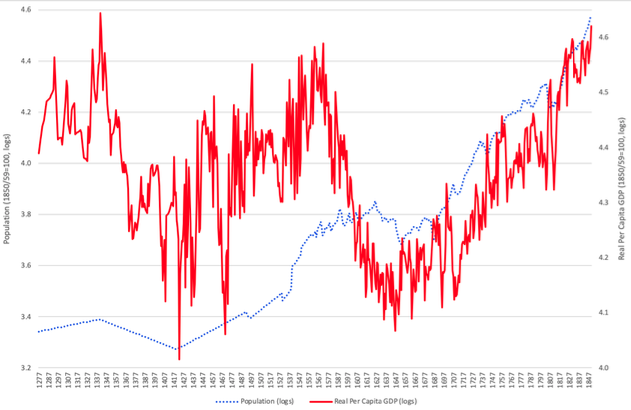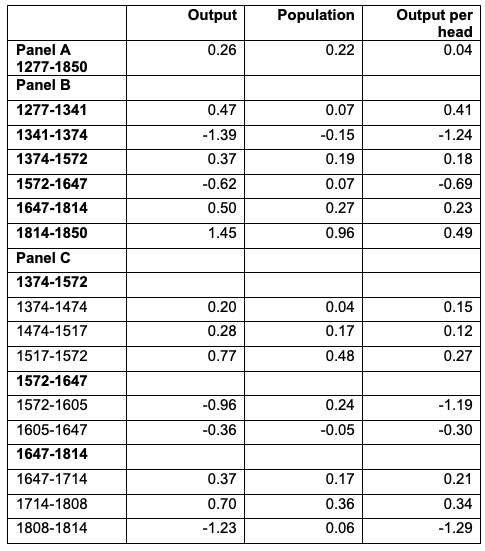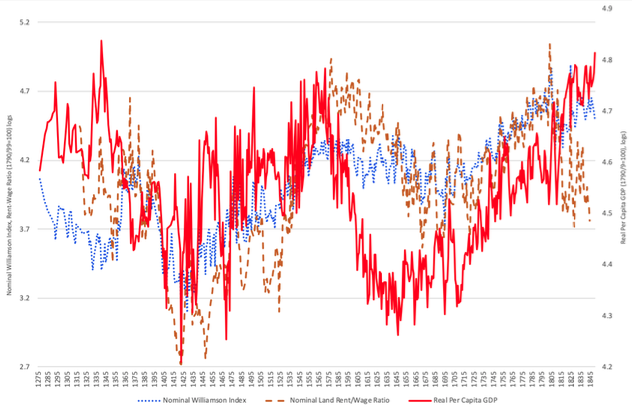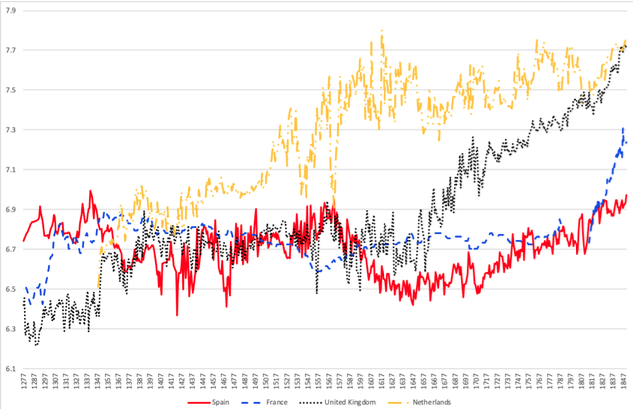Growth recurring in a preindustrial economy: Spain in a half-millennium perspective
Leandro Prados de la Escosura, Carlos Álvarez-Nogal, Carlos Santiago-Caballero 07 May 2020
“Prior to 1800, living standards in world economies were roughly constant over the very long run: per capita wage income, output, and consumption did not grow” wrote Gary Hansen and Edward Prescott (2002). This stylised fact has spread among economists in more simplified terms: human societies remained stagnant in terms of income per person until the Industrial Revolution heralded the beginning of modern economic growth.
While the Malthusian depiction of preindustrial societies finds support among distinguished scholars (Clark 2007, Clark 2008), this view has recently been challenged by some economic historians. They argue that the Malthusian constraint was overcome in pre-industrial Western Europe as capital accumulation and productivity gains permitted higher population and income levels simultaneously. However, these achievements seem to have been limited and occurred only for a short time after the Black Death for most of Western Europe, except for the North Sea Area where they had long-term effects (Pamuk 2007, Broadberry et al. 2015). Historians have further highlighted ‘efflorescences’ (Goldstone 2002) and ‘growth recurring’ episodes (Jones 1988), which are a succession of growing and shrinking phases in terms of output per head and which only give way to modern economic growth when the shrinking phases become less intense and frequent (Broadberry and Wallis 2017). Smithian growth, driven by gains from specialisation as international and domestic markets expanded, accounts for these episodes of sustained but reversible per capita income.
In a new paper (Prados de la Escosura et al. 2020), we provide yearly estimates of Spanish output and population over six centuries. We discuss to which extent ‘Malthusian’, ‘efflorescences’, ‘growth recurring’ or ‘Smithian growth’ are defining elements of pre-industrial Spain.
Population and GDP per capita in Spain ,1277–1850
In a first step, we show that population and output per head evolved simultaneously in Spain. This finding is at odds with the Malthusian narrative, and further provides support for the hypothesis that Spain was a frontier economy during pre-industrial times. Figure 1 displays Spain’s GDP and population growth after 1277. We see that phases of per capita growth were followed by shrinking phases. Shrinking phases after the 1340s and the 1570s, showed such sharp declines in GDP per capita that each subsequent growth phase started from a much lower level. This results in no significant long-term change in GDP per capita for more than half a millennium. The peak income levels of output per head reached in the 1340s and the 1570s are only overcome in the early 19th century.
Figure 1 GDP per head and population, 1277-1850 (1850/9=100, in logs)

Still, we can overall distinguish a plateau of relatively high GDP per capita from the late thirteenth to the late sixteenth century (with a deep drop after the Black Death) and a low plateau covering the seventeenth and early eighteenth century.
If we consider Table 1, we find evidence for Smithian growth during the long and rising phase up to the Black Death (1348), then during the century-long expansion up to the 1570s and again during the sustained recovery from the late seventeenth century up to the Peninsular War in 1808-1814.
Table 1 Output and population Growth, 1277-1850 (%)

Note: * Annual average logarithmic rates. Periodization corresponds to that of output per head. Panel B, trough (peak) to peak (trough) growth rates. Panel C, breakdown of expansion and contraction phases.
Spain as a frontier economy and the impacts of the Black Death
In late medieval and early modern Spain, in a context of low population density and high land-labour ratios demographic expansion led to increasing economic returns for a largely pastoral society driven by urban nuclei with good connections to international trade networks. The frontier economy then helps explain why the Black Death had such devastating economic consequences in Spain, despite its comparatively milder demographic impact as the Plague destroyed a pre-existing fragile equilibrium (Álvarez-Nogal and Prados de la Escosura 2013). The fact that factor proportions (high land-labour ratios and, hence, high non-agricultural relative prices) in post-Plague western Europe (Pamuk 2007) were similar to those in pre-Plague Spain helps explain why the Black Death had only negative consequences in Spain.
Figure 2 shows Spain’s income distribution for the period. In the frontier economy, until the mid-16th century living standards were relatively high and incomes were distributed in a rather egalitarian way. This implies that Spain’s overseas expansion can be seen as an endeavour of a relatively advanced society, and not only as the result of the inflow of silver from the Americas at the time. However, a new equilibrium seems to have been reached after the mid-17th century with agriculture playing an increasingly central role. The relative importance of land as a productive factor then lead to a poorer and more unequal society.
Figure 2 Inequality and real GDP per capita 1277-1850 (nominal Williamson index and rent-wage ratio, 1790/99=100, in logs)

Spain’s development in international comparison
Figure 3 shows Spain’s development in comparison to other European countries for the same period. While Spain was a frontier economy it did not experience any significant long-run gains in living standards. Why? If we would extrapolate its per capita growth trend from the 16th century, Spain would have matched Britain in the 18th century. However, long-run growth was cut short after the 1570s, giving way to a sustained decline and then falling behind Western Europe. A potential explanation for this development is the unintended consequences of Spain’s efforts to keep its European empire. It can be hypothesised that sustained increases in fiscal pressure on urban activities, the locus of the commercial and industrial expansion in the sixteenth century, in order to finance increasingly expensive imperial wars in Europe placed an unbearable burden on the most dynamic sectors. This triggered de-urbanisation and led to a collapse of average real incomes from which early modern Spain never fully recovered. If that were the case, the European empire would have led to the collapse of a relatively affluent nation.
A further explanation for the divergence of Spain and the North Sea Area (England and the Low Countries) after the 1570s is that while the surge in urban demand in the North Sea Area increased peasants incentives to raise their purchasing power in order to access new urban goods and services and consequently triggered an agricultural revolution, in Spain, conversely, the lack of urban stimulus led to a decline in agricultural labour productivity and a shrinking labour force in the countryside. This scenario is again at odds with the conventional Malthusian narrative.
Figure 3 Real per capita GDP 1270-1850 in Spain and Western Europe ($1990, in logs)

Sources: Spain (Prados de la Escosura et al. 2020), France (Ridolfi 2016), Netherlands (van Zanden and van Leeuwen 2012) United Kingdom (Broadberry et al. 2015).
It was only in the early 19th century that Spain started to experience sustained growth, with population and GDP per capita growing faster than in previous phases of expansion. However, this development still fell short of taking Spain back to the leading position it enjoyed in previous centuries.
References
Álvarez-Nogal, C and L Prados de la Escosura (2013), “The Rise and Decline of Spain, 1270-1850”, Economic History Review 66(1): 1-37.
Broadberry, S N, B M S Campbell, A Klein, M Overton and B van Leeuwen (2015), British Economic Growth, 1270-1870, Cambridge: Cambridge University Press.
Broadberry, S N and J Wallis (2017), “Growing, Shrinking and Long Run Economic Performance: Historical Perspectives on Economic Development”, CEPR Discussion Papers 11973.
Clark, G (2007), A Farewell to Alms. A Brief Economic History of the World, Princeton: Princeton University Press.
Clark, G (2008), “In Defense of the Malthusian Interpretation of History”, European Review of Economic History 12:175–199.
Goldstone, J A (2002), “Efflorescences and Economic Growth in World History: Rethinking ‘The Rise of the West’ and the Industrial Revolution”, Journal of World History 13(2): 323-389.
Hansen, G D and E C Prescott (2002), “Malthus to Solow”, American Economic Review 92(4): 1205-1217.
Jones, E L (1988), Growth Recurring: Economic Change in World History, Oxford: Oxford University Press.
Pamuk, S (2007), “The Black Death and the Origins of the 'Great Divergence' across Europe, 1300-1600”, European Review of Economic History 11 (3): 289-317.
Prados de la Escosura, L, C Álvarez-Nogal and C Santiago-Caballero (2020), “Growth Recurring in Preindustrial Spain: Half A Millennium Perspective”, CEPR Discussion Paper 14479.
https://voxeu.org/article/growth-recurring-preindustrial-economy
No hay comentarios:
Publicar un comentario